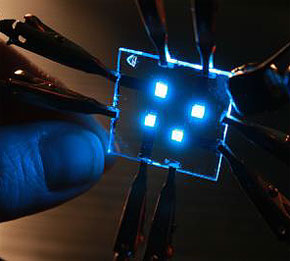SALT LAKE CITY, March 23, 2009 – Lighting consumes one-fifth of the electricity generated in the US, making advancements in solid-state lighting crucial to corralling our energy consumption as a nation.
Recent research, however, has revealed that new materials are now being used to boost the efficiency of blue organic light-emitting diodes (OLEDs). 
New, more efficient host materials for the blue phosphorescent OLED have been designed, developed and tested by Pacific Northwest National Laboratory scientists. By using new host materials, scientists have been able to improve the efficiency by at least 25 percent and have unlocked doors to developing much more efficient white OLEDs. (Photo: Pacific Northwest National Laboratory)
“The weakest link in OLED research is the absence of an efficient, long-lasting blue light to accompany the red and green,” said Pacific Northwest National Laboratory scientist Asanga Padmaperuma.
Development of better host materials to manage the flow of electricity through the device could help solve that problem.
OLEDs are multilayered devices that produce light by running an electrical current through a specially engineered host material into which light-producing phosphorescent molecules are embedded or “doped.”
According to Padmaperuma, he and his colleagues have designed, synthesized and tested new materials that purportedly improve the power efficiency of blue OLEDs by at least 25 percent. Unfortunately, they are not offering any more details at this time.
Padmaperuma is discussing his findings at the spring meeting of the American Chemical Society, March 22-26 in Salt Lake City.
For more information, visit: www.pnl.gov